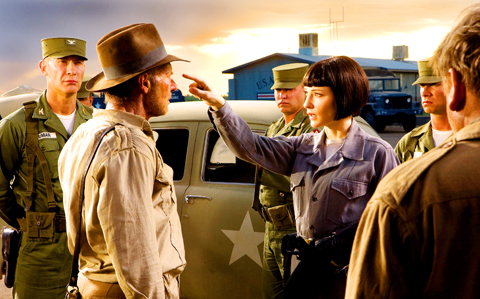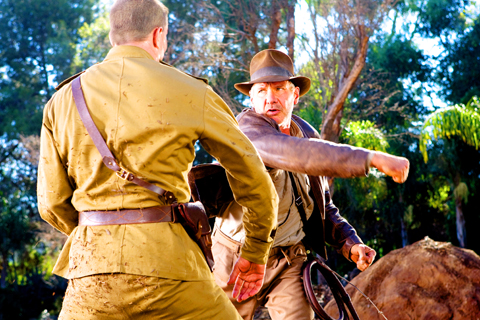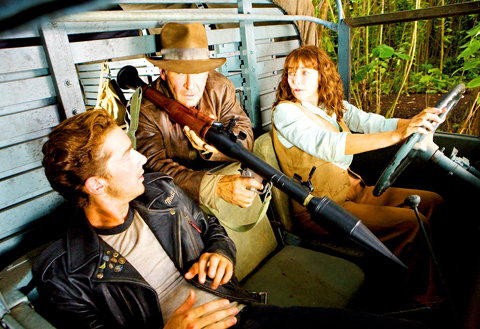Indiana Jones and the Kingdom of the Crystal Skull is a movie for boomers of all ages, though you can bet the bank that plenty of tots will be tagging along with Mom and Dad, Granny and Gramps. Like the 1981 blockbuster Raiders of the Lost Ark, the first in a monster franchise that has spawned two previous movie sequels, a television series, comics, novels, video games and Disney theme-park attractions, this new one was directed by Steven Spielberg, cooked up and executive produced by George Lucas (with Kathleen Kennedy) and stars Harrison Ford as the archaeologist-adventurer-sexpot with the sardonic grin, rakish fedora and suggestive bullwhip.
This latest Indy escapade serves as a reunion for the principal creative team. Almost two decades have lapsed since the third installment in the series, Indiana Jones and the Last Crusade (1989). In the years since, Lucas continued to build his special-effects empire and resurrected the Star Wars franchise while Spielberg has oscillated between serious-minded projects and financially instrumental entertainments.
For his part, Ford rode the ups and downs of high-concept stardom, oscillating between roles that called for him to flash his customary wry grin or his equally familiar grumpy frown. He wears both in The Crystal Skull, though the busy story makes enormous effort to keep the mood happy and snappy and decidedly PG-13 friendly — PC friendly, too, as in politically correct, with fewer dark-skinned people popping their eyeballs. Not that Indy has gone soft or the natives have gone hard, mind you, only that Spielberg no longer seems as eager to cut down extras for a laugh.

PHOTO: COURTESY OF UIP
Thank goodness for the fall of the Soviet Union and the rise of Vladimir Putin, which have expedited the return of blond-haired, blue-eyed villainy to the screen. Set in 1957, this new Indy yarn, written by David Koepp from a story by Lucas and Jeff Nathanson, takes place far from the Middle East even if it opens in a desert. The bad guys this time are Cold War Reds first seen poking around an American military base and led by Irina Spalko. A caricature given crude, playful life by Cate Blanchett, Irina owes more than a little to Rosa Klebb, the pint-size Soviet operative played by Lotte Lenya, who took on James Bond in From Russia With Love.
Dressed in gray coveralls, her hair bobbed and Slavic accent slipping and sliding as far south as Australia, Blanchett takes to her role with brio, snapping her black gloves and all but clicking her black boots like one of those cartoon Nazis that traipse through earlier Indy films. She’s pretty much a hoot, the life of an otherwise drearily familiar party. Among the other invited guests are Ray Winstone, John Hurt and Shia LaBeouf, who plays Mutt, the young sidekick onboard to bring in those viewers whose parents were still in grade school when the first movie hit. Karen Allen, who played Indy’s love interest in Raiders, is here too, with a megawatt smile and a bit of the old spunk.
If only the filmmakers seemed as eager to see — and to please — the audience as Allen. There’s plenty of frantic energy here, lots of noise and money too, but what’s absent is any sense of rediscovery, the kind that’s necessary whenever a filmmaker dusts off an old formula or a genre standard. Raiders of the Lost Ark creaks with age now, but to look at it again is to see Spielberg actively engaging in an organic whole, taking a beloved template and repurposing it for the modern blockbuster age he helped create. By contrast, The Crystal Skull comes alive only in isolated segments, in a clever motorcycle chase that ends in a library and, best of all, in an eerie sequence at an atomic test site that wittily puts the nuclear in family.

PHOTO: COURTESY OF UIP
The original Indiana Jones venture was inspired by Lucas and Spielberg’s love for 1930s serials, but you’d be hard pressed to find much inspiration in their latest collaboration. There’s plenty of perspiration, of course, what with the wall-to-wall chases — many tricked out with obvious computer-generated effects — that careen one into another like colliding big rigs. As expected, the high leaps and long jumps look impressive, even if it’s something of a bummer when one of the best directors working today (Spielberg) doesn’t seem to be working as hard as the stunt crew. Initially, I thought he was bored with the material (he wouldn’t be alone), but now I think he’s just grown out of this kind of sticky kids’ stuff.
Creative ennui certainly might explain why he spends so much time riffing both on his own greatest hits — Indy and company have an encounter of a close, insipid kind — and on other movies. Some of these allusions amuse (a sea of red ants parting a la The Ten Commandments) while others are just painful (LaBeouf done up to resemble Marlon Brando in The Wild One). It’s odd to see Spielberg recycling plot points already chewed through by Roland Emmerich in Stargate, though Indy’s brief encounter with some ferociously feathered Indians who look right out of Mel Gibson’s Apocalypto was a tantalizingly sweet pip, a sequel in waiting (“Indiana Jones Meets Mad Max”) or maybe just a YouTube mash-up.

PHOTO: COURTESY OF UIP

April 28 to May 4 During the Japanese colonial era, a city’s “first” high school typically served Japanese students, while Taiwanese attended the “second” high school. Only in Taichung was this reversed. That’s because when Taichung First High School opened its doors on May 1, 1915 to serve Taiwanese students who were previously barred from secondary education, it was the only high school in town. Former principal Hideo Azukisawa threatened to quit when the government in 1922 attempted to transfer the “first” designation to a new local high school for Japanese students, leading to this unusual situation. Prior to the Taichung First

The Ministry of Education last month proposed a nationwide ban on mobile devices in schools, aiming to curb concerns over student phone addiction. Under the revised regulation, which will take effect in August, teachers and schools will be required to collect mobile devices — including phones, laptops and wearables devices — for safekeeping during school hours, unless they are being used for educational purposes. For Chang Fong-ching (張鳳琴), the ban will have a positive impact. “It’s a good move,” says the professor in the department of

On April 17, Chinese Nationalist Party (KMT) Chairman Eric Chu (朱立倫) launched a bold campaign to revive and revitalize the KMT base by calling for an impromptu rally at the Taipei prosecutor’s offices to protest recent arrests of KMT recall campaigners over allegations of forgery and fraud involving signatures of dead voters. The protest had no time to apply for permits and was illegal, but that played into the sense of opposition grievance at alleged weaponization of the judiciary by the Democratic Progressive Party (DPP) to “annihilate” the opposition parties. Blamed for faltering recall campaigns and faced with a KMT chair

Article 2 of the Additional Articles of the Constitution of the Republic of China (中華民國憲法增修條文) stipulates that upon a vote of no confidence in the premier, the president can dissolve the legislature within 10 days. If the legislature is dissolved, a new legislative election must be held within 60 days, and the legislators’ terms will then be reckoned from that election. Two weeks ago Taipei Mayor Chiang Wan-an (蔣萬安) of the Chinese Nationalist Party (KMT) proposed that the legislature hold a vote of no confidence in the premier and dare the president to dissolve the legislature. The legislature is currently controlled